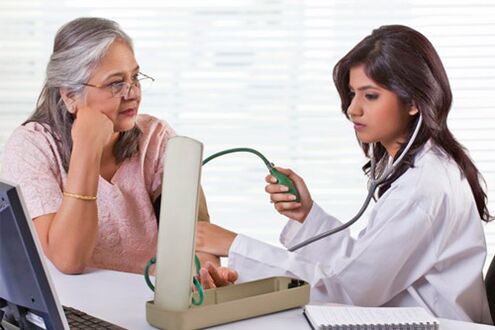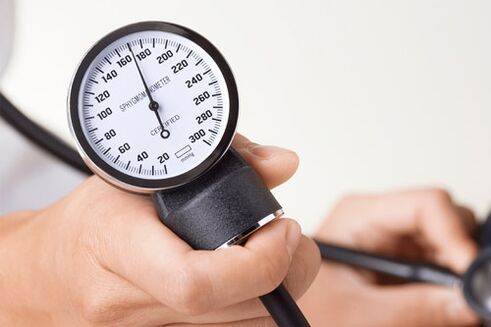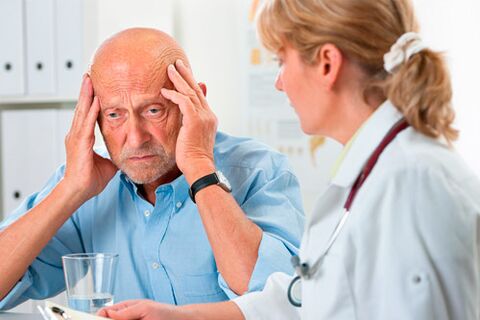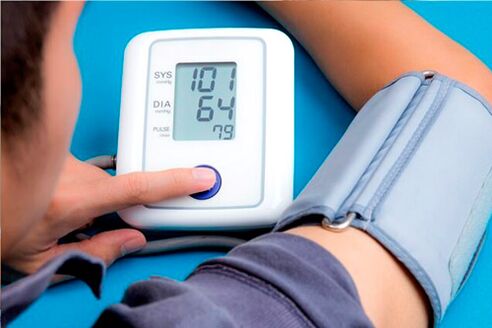Age-related characteristics of an individual at different times in their lives, external and internal causes, changes in hormone levels, bad habits, and psycho-emotional factors can affect changes in blood pressure and lead to an increase in it. People don’t always go to the doctor on time, so high blood pressure takes a constant form. The article is about the symptoms of high blood pressure and the differences from hypotension.
First manifestations

High blood pressure is characterized by morphological changes in the blood vessels that affect a person’s overall well-being. To understand whether a person has high blood pressure and what symptoms are characteristic of this pathology, you need to know the simplest self-diagnostic methods to help you react correctly to jump indicators and prevent complications.
High blood pressure is one of the most common diseases. High blood pressure occurs in every third person and is characterized by a high mortality rate in the severe stage. Only a complex treatment that combines medication with the maintenance of a healthy lifestyle can be successful.
High blood pressure is characterized by a gradual, long, slow course and is initially characterized by the absence of severe symptoms. At high pressure, the presence of the disease may be indicated by intermittent symptoms such as:
- pain in the occipital or temporal region;
- dizziness;
- hearing loss, tinnitus;
- blurred vision;
- tachycardia and chest pain;
- nausea and vomiting reflex;
- shortness of breath;
- anxiety;
- irritability;
- sweating or chills;
- recurrent epistaxis.
The presence of at least one of the above symptoms of hypertension, which may be the first, warrants a visit to a general practitioner or therapist for diagnostic and prophylactic purposes, since in the advanced, untreated state of the disease, frightening complications such as myocardial infarction and ischemic stroke.
Characteristics of symptoms
Arterial hypertension always resolves with a headache in the back of the head or on the temple, which is well stopped at the beginning of the pathology by painkillers. Its occurrence is accompanied by a change in the lumen of the cerebral vessels in the direction of stenosis. Those who experience a high blood pressure headache describe it as dull or crampy in the back of the head, and sharp, stabbing, throbbing in the temporal region.
Tinnitus and high blood pressure can be caused by damage to the blood vessels in your hearing aid.
Important! Sudden pain in the head is a direct indication for pressure measurement.
Impaired vision in the presence of high blood pressure is accompanied by a lack of blood supply to the retina in the form of double, flickering dots (flies) in the eye and a deterioration in the function of the optic nerves.
Nausea and gag reflex occur as a reaction to headache and dizziness, and frequent heartbeat and pain behind the sternum are due to dysfunction of the blood vessels in the lungs. The feeling of shortness of breath (shortness of breath) is characterized by high blood pressure and is more common in obese patients at any age.
Frequent occurrence of symptoms of high blood pressure can cause a hypertensive condition. Hyperemia of the facial skin, anxiety, and heart pain are then associated with the above signs of pathology. This condition does not go away on its own and requires emergency treatment.
Important! Intermittent symptoms of high blood pressure make the patient seek medical attention and begin treatment. The asymptomatic course of the disease steals valuable time from the person.
Tonometer indicators
To understand if there is an increase in pressure, it is necessary to measure the indicators at regular intervals with a tonometer under different conditions (well-being, bad) and to know their standards.
The standard values are 120/80 mmHg. Art. The range of 10 units is no deviation from this data. Signs of an increase greater than 140/90 mmHg. Art. , In combination with headache, nausea, heart pain, is considered a symptom of arterial hypertension.
Important! The pressure in a person is always individual, depending on the body and external causes. "Work tone" - these are the blood pressure numbers at which the patient is feeling well. Hypertensive patients know their normal values and control them by taking the antihypertensive medicines chosen by their doctor in time.
Characteristics of degrees of pathology
Signs of high blood pressure depend directly on the elevation of the indicators, of which there are 3 in high blood pressure. They can be presented in the form of tables:
| Degrees of high blood pressure | Systolic index (Hgmm) | Diastolic numbers (mmHg) | The main symptoms of high blood pressure |
|---|---|---|---|
| 1 degree | 140-160 | 90-100 | They pass without a clear clinic, are characterized by intermittent elevation, and return to normal rapidly. Rarely, dizziness, insomnia, head heaviness are located, located in the back of the head. |
| 2 degrees | 160-180 | 100-110 | Pain in the occipital or temporal region is severe, accompanied by nausea, dizziness, weakness, and insomnia. |
| 3 degrees | Up to 182 and above | Over 110 | Intolerable headache (especially in the morning), nausea, vomiting, tinnitus, blurred vision, shortness of breath, sweating, tachycardia, swelling of the lower extremities, thirst, difficulty urinating. |

The clinic for hypertension may be mild in the initial stage. For a long time, a person may not even be aware of the increased pressure and processes in the vessels. Early and first signs of high blood pressure are irritability and increased fatigue for no apparent reason.
Symptoms of hypertension in 2 and 3 degree hypertension with systolic values above 160 mm. may lead to a hypertensive crisis characterized by severe headache of various kinds, nausea, vomiting, blurred vision (fog, shroud) or flickering of small dots, as well as: tremors in the limbs, rapid heartbeat, shortness of breath, heartache, arrhythmia, loss of consciousness.
What is arterial hypertension - every hypertensive patient knows. It’s helpful to know how you can help yourself or your loved ones before an ambulance arrives when an emergency first occurs:
- Place 1 tablet of validated or nitroglycerin under the tongue.
- Arrange for air access, loosen tight clothing, and place the patient in an elevated position in bed (lift up on the pillows).
- Apply mustard to the calf muscles.
- Add 30 drops (1 tablespoon) of alcoholic solution of catnip and motherwort.
- Take any painkillers for the headache and lubricate the whiskey, forehead, neck and ears with mint oil.
- You can soak your feet in hot water for 15 minutes.
In addition, doctors recommend performing a simple exercise to restore breathing. To do this, it is recommended to take a deep breath, hold your breath and then breathe very slowly. This should be done 3-5 times. The position of the body in this case should be horizontal.
Important! Early help from a patient with a hypertensive crisis can lead to a stroke or heart attack. Because Grades 2 and 3 are incurable, the patient should be kept under constant pressure.
Age characteristics
Increased pressure in people over the age of 50 is often associated with initial heart and blood vessel problems, atherosclerosis, anemia, hyperthyroidism, and impaired kidney function. Shortness of breath, marked swelling in the legs, arrhythmia may occur. Compared to men, women are more likely to get sick.
Symptoms of high blood pressure always result from age-related changes in the blood vessels that cause them to lose their elasticity. In addition to the clinical features of high blood pressure, it is possible to add intermittent claudication, frequent fainting, dizziness, headaches, and compression pain behind the sternum. General malaise, decreased performance, and weakness also occur.
Because the increase in rates may occur in people of different ages, symptoms of hypertension in adolescents may occur from the age of 12 years (during puberty) and may continue until the age of 17 years. This is due to the rearrangement of the body and changes in hormonal metabolism. . Signs of increased blood pressure in a teenager include increased sweating, heavy heartbeat, tinnitus, dizziness, headache at any time of the day, insomnia, hot flushes on the facial skin, and discomfort in the epigastric region. .
Important! In order to ensure that in this case possible pathology of the blood vessels occurs, the pressure in one person should be measured several times in a row, preferably every 15 minutes. These indicators should be recorded and reported to your doctor to prescribe appropriate treatment. What medications to take - the doctor decides.

If you notice more symptoms accompanied by an increase in blood pressure, you should see a doctor, examine and identify the real cause of such pathology: tumors, kidneys, endocrine, vascular diseases. The therapist, neuropathologist, and GP prescribe appropriate treatment based on diagnostic data, functional characteristics of the body, age, comorbidities, and predisposition to allergies.
Adrenoblockers, diuretics, ACE inhibitors, slow calcium channel blockers are prescribed for high blood pressure.
Apply physiotherapy - electrocution; magnetotherapy; UHF therapy; infrared laser therapy as well as traditional medicine. Patients with high blood pressure are advised to follow a diet with enough fruits and vegetables.
Important! Preventive measures to prevent the development of vascular pathology and high blood pressure include timely visits to medical examinations, normalization of work and rest, moderate nutrition, fight against overweight, prevention of stressful situations, use of adequate amounts of water and vegetables. , fruits and the elimination of nicotine and alcohol dependence (if any).
Differences between high and low pressure
In addition to the signs of high blood pressure, the rate of which may increase, there are also manifestations of low blood pressure called hypotension.
The periodic decrease in pressure is characterized by indicators below 101/66 mmHg. Art. It depends on all ages, so the numbers may vary.
Although the presence of intolerable paroxysmal headaches occurs in both hypotension and hypertension, with a decrease in pressure, the following symptoms appear, which distinguish high pressure from low:

- Poor health and weakness. From the morning onwards, the patient feels weak and unwell.
- Cold limbs. Hands and feet are constantly cold.
- Noise in the ear (intermittent presence).
- Discomfort in the heart region, tachycardia. Every patient has their own feelings.
- Dizziness and frequent darkening (sometimes double vision) in the eyes. Such symptoms are common not only in the morning but also during the day.
- Drowsiness during the day, sleep disturbance at night. Patients should be asleep continuously throughout the day. The peak of activity begins in the evening. The night is restless, the sleep is shallow.
- Digestive problems. Hypotonic patients often suffer from gastritis, liver problems, constipation, dyspepsia, and dysbacteriosis.
The above characteristic symptoms are most common in young people, mostly in women. The reasons for the decrease in blood pressure are stress, lack of sleep, poor lifestyle, vitamin deficiency, the use of strict diets, hormonal disorders, intense physical and mental stress, the presence of certain somatic diseases (endocrine, cervical osteochondrosis, liver, kidney). , VVD, sedentary lifestyle). Prolonged depression may be a major cause of low blood pressure.
The first "bells" from the onset of hypotension occur when a person gets out of bed in the morning, feels overwhelmed, irritated, and does not get enough sleep. After a while (everyone is purely individual) there is a headache that doesn’t go away until lunch.
Here, the common symptoms of high blood pressure are nausea, vomiting, meteorological dependence and fainting, a long asymptomatic course. You can increase your low blood pressure by taking special medications, diet therapy, herbs, and a healthy lifestyle.
Therapy
Drugs that increase blood pressure include tinctures of Eleutherococcus or Ginseng, which are special drugs. Caffeine has the same effect.
Herbal medicine involves the infusion of decoctions and herbs from plants such as St. John's wort, lemongrass, ginseng, immortelle, tartar, ginger.
Consumption of small amounts of alcohol is acceptable for patients with hypotension. For a week, a glass of red wine or 25 g of cognac is good for the body: it dilates blood vessels and improves blood circulation. A cup of coffee in the morning brings a good mood.
Hypotensive patients need to get enough sleep to feel awake (more than 8 hours a day), exercise enough, eat a balanced diet, and exercise moderately (morning exercises, swimming, aerobics, yoga, outdoor games), and rinse with contrast. showering, alternating with massage.
Important! Untreated hypotension can turn into high blood pressure after the age of 40.
Everyone is advised to check their blood pressure carefully. The tonometer should be used at rest, in good and bad health, after sleep and at night. It is desirable to record all indicators, compare and determine the "you" pressure at which the best work ability and vital activity is seen.
If the increased numbers persist for a long time, be sure to see a doctor to protect yourself from future fatal complications. To be healthy!



























